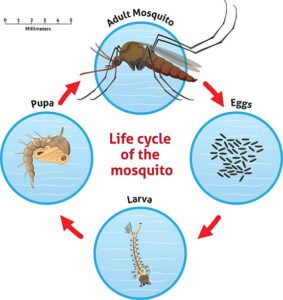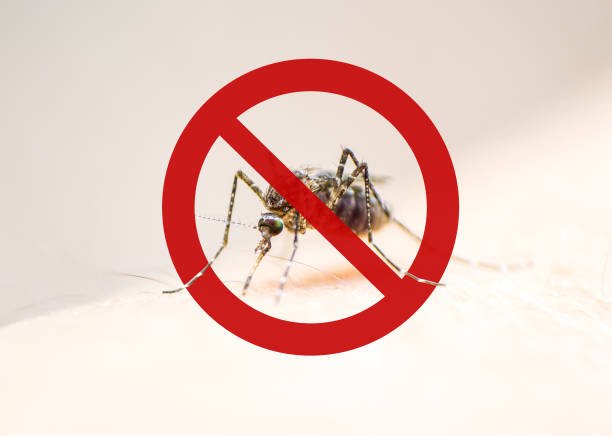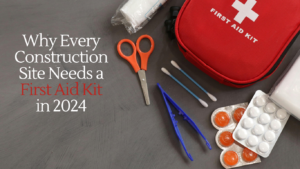Egg Stage
Deposition: Female mosquitoes lay their eggs in various water sources, ranging from stagnant ponds and marshes to artificial containers like tires and flowerpots.
Adaptations: Mosquito eggs are equipped with specialized structures, such as floats or adhesive coatings, allowing them to survive and hatch in water.
Larval Stage
Hatching: Upon exposure to water, mosquito eggs hatch into larvae, commonly known as “wigglers.”
Feeding Behavior: Mosquito larvae are primarily filter-feeders, consuming organic matter and microorganisms present in their aquatic habitat.
Development: Larvae undergo several molts, growing in size until they reach the pupal stage.
Pupal Stage
- Transformation: Mosquito larvae develop into pupae, characterized by their comma-shaped bodies and distinct appendages.
- Metamorphosis: During the pupal stage, mosquitoes undergo a dramatic transformation from aquatic larvae to aerial adults.
- Respiration: Pupae breathe through specialized respiratory structures, known as “trumpets,” which extend above the water surface.
Adult Stage
- Emergence: Adult mosquitoes emerge from pupae onto the water surface, where they undergo a process called eclosion.
- Feeding Behavior: Female mosquitoes require blood meals for egg production, while males primarily feed on nectar and plant juices.
- Reproduction: Mating occurs shortly after adult emergence, with females seeking suitable hosts for blood feeding and oviposition.
- Environmental Factors
- Habitat Preferences: Mosquito species exhibit varying habitat preferences, ranging from freshwater habitats to urban environments with artificial containers.
- Temperature and Moisture: Environmental factors such as temperature and moisture levels influence mosquito development and activity, with warmer temperatures and stagnant water favoring rapid reproduction.
Impact on Disease Transmission
- Vector-Borne Diseases: Mosquitoes play a significant role in the transmission of various diseases, including malaria, dengue fever, Zika virus, and West Nile virus.
- Host-Seeking Behavior: Female mosquitoes seek blood meals from vertebrate hosts, facilitating the transmission of pathogens between susceptible individuals.
Understanding the life cycle and biology of mosquitoes provides valuable insights for implementing targeted mosquito control measures and reducing the risk of mosquito-borne diseases. By disrupting key stages of the mosquito life cycle ,we can prevent mosquito breeding. Minimizing breeding habitats, effective mosquito management strategies can help mitigate public health risks associated with these vector insects.
The Ultimate Guide to Mosquito Prevention, Treatment, and Control in The World
Mosquitoes are more than just a nuisance in the world right now; they are a public health concern due to the diseases they can transmit, such as dengue fever and Zika virus. Effective prevention, treatment, and control of mosquitoes are essential for safeguarding peoples health. This guide provides comprehensive strategies to tackle mosquito problems, focusing on proactive measures, treatment options, and long-term control methods.In this guide we will explore-how to prevent mosquito breeding around us.

Prevention Strategies
Prevent mosquito breeding and bites is crucial in controlling their population and minimizing the risk of mosquito-borne diseases. Here are some effective prevention strategies:
Eliminate Standing Water:
Regularly check and remove standing water from containers, plant saucers, and other receptacles.
Ensure proper drainage in gardens and construction sites to prevent water accumulation.
Use Mosquito Repellents:
Apply insect repellents containing DEET, picaridin, or oil of lemon eucalyptus when outdoors.
Install mosquito screens on windows and doors to keep mosquitoes from entering homes.
Environmental Management:
Introduce natural predators, such as fish in ornamental ponds, to control mosquito larvae.
Implement landscaping strategies that avoid water stagnation, such as filling potholes and leveling ground surfaces.
Treatment Options
When it comes to treating mosquito infestations, there are several effective options available to manage and reduce their population:
Chemical Treatments:

Use larvicides in stagnant water to prevent mosquito larvae from developing into adults.
Apply adulticides through fogging or spraying to reduce adult mosquito populations.

Biological Control:
Employ biological agents like Bacillus thuringiensis israelensis (Bti) to target mosquito larvae.
Introduce mosquito fish (Gambusia affinis) into water bodies to naturally control mosquito larvae.
Long-Term Control Measures-Community Engagement:
Educate the public about the importance of eliminating mosquito breeding sites and using protective measures.
Encourage community participation in clean-up campaigns and regular inspections of potential breeding areas.
Integrated Pest Management (IPM):
Implement an IPM approach combining biological, chemical, and environmental methods for sustained mosquito control.
Monitor mosquito populations and adapt strategies based on surveillance data to ensure effective control.
Government Initiatives-Regulations and Policies:
Enforce regulations requiring property owners to maintain their premises free of mosquito breeding sites.
Implement fines and penalties for non-compliance with mosquito control measures.
Public Health Campaigns:
Launch public awareness campaigns to educate citizens about the risks of mosquito-borne diseases and prevention strategies.
Provide resources and support for community-led mosquito control initiatives.
Technological Innovations
Smart Surveillance Systems:
Utilize smart technology and data analytics to monitor mosquito populations and predict outbreaks.
Deploy automated traps and sensors to track mosquito activity and inform targeted control measures.
Genetic Control Methods:
Explore the use of genetically modified mosquitoes to reduce mosquito populations through sterile insect techniques or gene drives.
Assess the potential benefits and risks of genetic control methods in the local context.
By integrating these strategies, we can effectively manage prevent mosquito breeding around us and minimize the risk of mosquito-borne diseases, ensuring a healthier and safer environment for all us.
Professional Mosquito Treatment for Prevent Mosquito Breeding
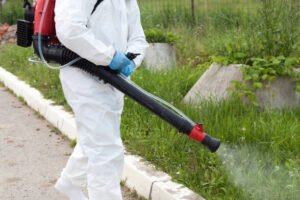
While prevention efforts play a crucial role in controlling mosquito populations, sometimes it’s necessary to seek professional assistance to effectively manage infestations. Professional mosquito treatment services offer specialized expertise and tools to target and eliminate mosquitoes, reducing the risk of bites and disease transmission.
Professional mosquito treatment involves the application of insecticides and other control methods by trained technicians to eliminate mosquitoes and their breeding sites. These treatments can be particularly effective in areas where mosquito populations are high or when traditional prevention methods have proven insufficient.
Assessment and Inspection
- Site Inspection: Experienced technicians make a detailed inspection of the property to find out mosquito breeding spots and areas.
- Identification of Species: Different species of mosquitoes may require different treatment approaches. Technicians can identify the specific types of mosquitoes present and tailor treatment accordingly.
Treatment Application
- Targeted Application: Utilizing specialized equipment, technicians apply insecticides to targeted areas where mosquitoes breed and congregate, such as standing water sources, vegetation, and shaded areas.
- Control Methods: In addition to insecticide application, professional treatments may include larviciding to target mosquito larvae, as well as residual treatments to deter adult mosquitoes from resting and breeding in treated areas.
Follow-Up Monitoring
- Monitoring Efforts: Following treatment, technicians may conduct follow-up visits to assess the effectiveness of the treatment and identify any remaining mosquito activity.
- Adjustments and Re-Treatment: Based on monitoring results, adjustments may be made to treatment strategies, and additional treatments may be applied as needed to maintain mosquito control.
Integrated Pest Management (IPM)
- Comprehensive Approach: Professional mosquito treatment often incorporates integrated pest management (IPM) principles, which focus on long-term, sustainable solutions to pest control.
- Environmental Considerations: Technicians may recommend environmental modifications and ongoing maintenance practices to minimize mosquito breeding opportunities and reduce reliance on chemical treatments.
Compliance with Regulations
- Regulatory Compliance: Professional mosquito treatment companies adhere to local regulations and guidelines regarding pesticide use and application practices.
- Certification and Training: Technicians undergo specialized training and certification to ensure safe and effective application of treatments while minimizing environmental impact.
Professional mosquito treatment services provide a valuable resource for controlling mosquito populations and reducing the risk of mosquito-borne diseases. By employing targeted treatments and integrated pest management strategies, these services can help maintain comfortable and safe outdoor environments for both residential and commercial properties.
Incorporating Landscaping Techniques
Effective landscaping can play a crucial role in preventing mosquito breeding by creating an environment that is less conducive to their proliferation. By strategically designing and maintaining your outdoor spaces, you can significantly reduce mosquito habitats.
Planting Mosquito-Repellent Plants:

Certain plants are known for their mosquito-repellent properties and can be incorporated into your landscaping to naturally deter mosquitoes. These plants include:
- Citronella: Well-known for its strong scent that repels mosquitoes.
- Lavender: Besides its pleasant aroma, lavender can help keep mosquitoes at bay.
- Marigolds: A very beautiful and bright flower which contain pyrethrum,a substance which is used in insect repellents.
- Catnip: Highly effective at repelling mosquitoes, even more so than DEET in some studies.
By planting these mosquito-repellent plants around construction sites and homes, you can create a natural barrier against mosquitoes while enhancing the aesthetic appeal of your landscape.
Modifying Landscaping for Proper Water Drainage:
Standing water is a primary breeding ground for mosquitoes, so it’s essential to design your landscaping to promote proper water drainage. Here are some key strategies:
- Grading: Ensure that your yard slopes away from structures to prevent water from pooling near foundations and other areas.
- Drainage Systems: Install French drains, swales, or other drainage solutions to manage runoff and prevent water from accumulating.
- Rain Gardens: Create rain gardens with plants that thrive in wet conditions to absorb excess water and reduce standing water.
- Regular Maintenance: Keep gutters clean and free of debris, and fill in low spots where water might collect.
By incorporating these landscaping techniques, you can effectively reduce the potential for mosquito breeding and create a healthier, more enjoyable outdoor environment.
Ways to Prevent Mosquito Bites
Mosquito bites can be more than just a nuisance; they can transmit serious diseases such as malaria, dengue fever, and Zika virus. Implementing effective strategies to prevent mosquito bites is crucial for protecting health and well-being.
Preventing mosquito bites involves a combination of personal protective measures, environmental modifications, and the use of mosquito repellents. By understanding and implementing these strategies, individuals can significantly reduce their risk of mosquito bites and the associated health risks.
Use of Mosquito Repellents
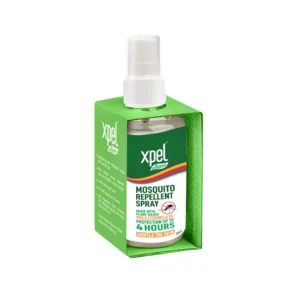
- Topical Repellents: Apply mosquito repellents containing DEET, picaridin, or oil of lemon eucalyptus to exposed skin.
- Permethrin-Treated Clothing: Wear clothing treated with permethrin for added protection.
This one mosquito repellents is one of the best one and you can surly try this.
Wearing Protective Clothing
- Long Sleeves and Pants: Wear long-sleeved shirts and long pants to minimize exposed skin.
- Light-Colored Clothing: Opt for light-colored clothing, as mosquitoes are attracted to dark colors.
Bug Zappers

- Details: Electronic devices that attract mosquitoes with UV light and kill them on contact with an electric grid, suitable for outdoor use.
As an electric device ,it works amazing for mosquito prevention and you should have this in your home and office.
Mosquito Nets and Screens

- Bed Nets: Use mosquito nets over beds, especially in areas with high mosquito populations or where mosquito-borne diseases are prevalent.
- Window and Door Screens: Install screens on windows and doors to prevent mosquitoes from entering indoor spaces.
Citronella Candles
- Details: Candles infused with citronella oil, which repels mosquitoes through the smoke and scent they release, ideal for patios and gardens.

Mosquito Traps
- Details: Devices that lure mosquitoes using carbon dioxide or attractants and trap or kill them, reducing mosquito populations over time.
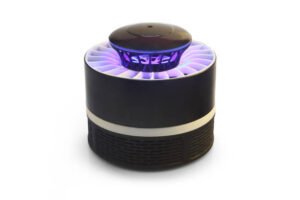
Environmental Modifications
- Eliminate Standing Water: Remove standing water from flowerpots, gutters, birdbaths, and other containers to prevent mosquito breeding.
- Maintain Clean Surroundings: Keep surroundings clean and well-maintained to reduce mosquito habitats.
Timing and Location Awareness
- Avoid Peak Activity Times: Mosquitoes are most active during dawn and dusk; plan outdoor activities accordingly.
- Choose Safe Locations: Stay in areas with less vegetation and standing water where mosquitoes are likely to breed.
Using Fans and Air Conditioning
- Air Circulation: Use fans to keep air circulating, as mosquitoes are weak fliers and can be deterred by the wind.
- Air Conditioned Spaces: Stay in air-conditioned areas where possible, as mosquitoes prefer warm, humid environments.
By combining these strategies, individuals can effectively reduce their exposure to mosquito bites and enjoy outdoor activities with a lower risk of mosquito-borne diseases.
Educating Workers and Residents
Effective mosquito control requires the active participation of everyone involved, including workers and residents. Education is key to raising awareness and ensuring that everyone understands the importance of preventing mosquito breeding. By conducting training sessions and distributing informational materials, you can equip people with the knowledge they need to take proactive measures.
Conducting Training Sessions:
Training sessions are an excellent way to inform workers and residents about the dangers of mosquito breeding and how they can contribute to prevention efforts. These sessions should cover:
- Identification of Breeding Sites: Teach participants how to recognize common mosquito breeding grounds such as stagnant water, clogged gutters, and uncovered containers.

- Preventative Measures: Provide practical tips on eliminating standing water, using mosquito repellents, and maintaining clean surroundings.
- Health Risks: Highlight the health risks associated with mosquito-borne diseases, such as dengue fever, Zika virus, and malaria, to emphasize the importance of control measures.
These training sessions can be conducted on-site for workers and in community centers or through local organizations for residents.
Distributing Informational Materials:
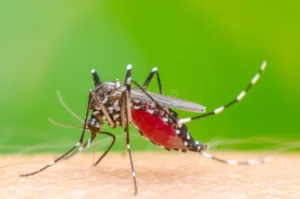
In addition to training sessions, distributing informational materials can help reinforce the message and ensure ongoing awareness. These materials can include:
- Flyers and Brochures: Simple, easy-to-understand guides that outline best practices for mosquito control and prevention.
- Posters: Visual reminders that can be placed in common areas, highlighting key actions like draining standing water and maintaining clean environments.
- Digital Resources: Utilizing emails, social media, and websites to share information and updates on mosquito control strategies.
By educating workers and residents through training sessions and informational materials, you can foster a community-wide effort to reduce mosquito breeding and protect public health.
Regular Inspections and Maintenance
To effectively control mosquito populations and prevent their breeding, it is essential to implement regular inspections and maintenance both at home and on construction sites. Consistent vigilance helps identify potential breeding sites early and allows for timely intervention.
Regular inspections and maintenance are crucial components of a comprehensive mosquito control strategy. By routinely checking for and addressing potential breeding sites, both at home and on construction sites, the risk of mosquito proliferation can be significantly reduced.
Scheduling Routine Inspections
- Construction Sites: Schedule regular inspections of construction sites to identify and eliminate standing water and other mosquito breeding habitats.
- Home Inspections: Conduct routine checks around the home, focusing on areas where water can collect, such as gutters, planters, and outdoor containers.
Establishing a Maintenance Schedule
- Mosquito Prevention Measures: Implement a regular maintenance schedule for mosquito prevention measures, ensuring that all strategies are consistently applied and updated as needed.
- Equipment and Supplies: Regularly check and maintain equipment and supplies used for mosquito control, such as foggers, sprays, and repellents, to ensure they are in good working condition.
By incorporating regular inspections and maintenance into your mosquito control plan, you can create a proactive approach to preventing mosquito breeding and reducing the risk of mosquito-borne diseases.
Conclusion
Incorporating regular inspections and maintenance into your mosquito control strategy is essential for effectively managing mosquito populations and preventing their breeding. By consistently monitoring both home and construction sites for potential breeding grounds and promptly addressing any issues, you can significantly reduce the risk of mosquito-borne diseases. Maintaining a proactive approach through routine checks and upkeep ensures that prevention measures remain effective and helps to create a safer, healthier environment for everyone. Stay vigilant, stay informed, and make mosquito prevention a regular part of your maintenance routine.
